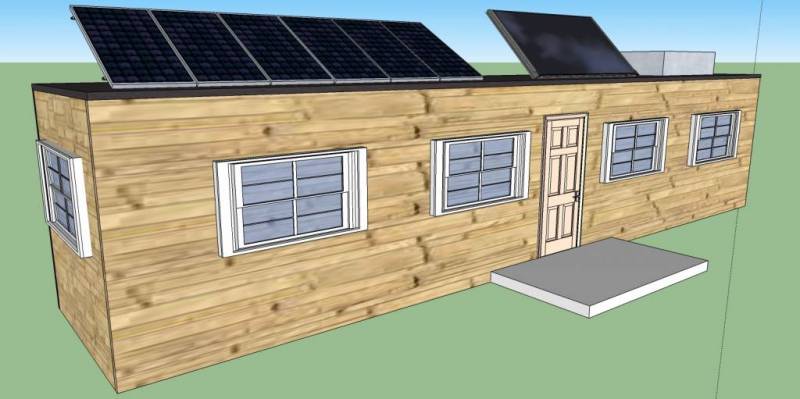Going off the grid is becoming increasingly popular. With the rise in environmental consciousness, more and more people are looking for ways to reduce their reliance on traditional energy sources and live a more sustainable lifestyle. But building an off-grid home or other structure can be a complex task that requires a range of skills and knowledge. There might even come a time where you might need to finance a scraper for as low as $750/month.
Amica Construction offers the expertise and versatility needed to bring sustainable building projects like these to life with confidence. Their experience with custom builds ensures that every detail—from energy-efficient systems to durable off-grid materials—is handled with precision. In this post, we’re going to take a look at some of the basics you need to consider when it comes to building an off-grid home!
Planning and Designing Your Off-Grid Home
When it comes to designing your off-grid home, you need to think about how best to maximize natural ventilation and insulation. This can be done through the use of passive solar design, which relies on the sun’s energy to heat and cool your home. You’ll also want to consider energy efficiency by looking at the size of your home and minimizing energy use. To complement these efforts, homeowners choose trusted painters from Green Dot Painting for a polished, lasting finish.
When it comes to renewable energy sources, you’ll need to consider things like solar panels, wind turbines, or a mini-hydro system. These will provide your home with energy and help reduce your reliance on traditional energy sources. You’ll also need to consider your water supply, as you won’t be connected to municipal water. Rainwater harvesting and/or a well can provide your home with the necessary water supply, in addition to gray water systems for collecting and reusing water.
Finally, you’ll need to think about how you will manage your waste. Composting and recycling can help reduce the amount of waste that goes to the landfill. As well, you may consider investing in a water filtration and treatment system to ensure your water is safe for drinking and bathing.
With the right planning and design, your off-grid home can be a sustainable and energy efficient living space that provides you with the comfort and convenience you need. So take the time to consider all of these elements and create a structure that is tailored to your needs and lifestyle. With the right approach, you can make your off-grid home a reality!

Materials Needed For Your Project
You may also need certain items to help create energy efficiency in your home, such as insulation or energy-efficient windows similar to the ones at tripleglazedwindows.uk. Insulation is important for keeping your home warm in the winter and cool in the summer, while energy-efficient windows can help keep your energy bills low. You can check this company for professional window installation.
When you have new windows installed, you don’t expect to need to replace them within a few years. This is why it is important to make the right decision when choosing between double or triple glazing for your windows. Why not check out here differences between double and triple glazing?
Additionally, you may need additional materials to protect your home from the elements, such as weatherproofing, waterproofing, or shingles. See Colony Roofers or visit sites like https://knipp-roofing.com/ for more information. Finally, you should also consider the materials needed to furnish and decorate your off-grid home. Natural items such as wood furniture, rugs, and curtains can help create a cozy and inviting atmosphere. You can find a variety of items when you visit stores like Home Accents II furniture or California Backyard accessories.
It’s important to do your research before purchasing any materials for your project in order to ensure you are getting the most sustainable and energy-efficient items available for your roof so you know these materials are durable as there are different roof lifespan expectations depending of the materials you use. By investing in renewable materials for your off-grid home, you can help reduce your carbon footprint and live a more sustainable lifestyle.

Construction Techniques
Carpentry:
When building frames for an off-grid home, it’s important to ensure that the frames are sturdy and able to withstand the elements. This may involve cutting and planing wood, assembling structures using screws or nails, and finishing the frames with varnish or paint with the help of painting contractors.
Bricklaying:
Installing walls to your off-grid home requires careful planning and bricklaying techniques. This includes laying bricks in a mortar bed, using bonding agents to hold the bricks together, and cutting the bricks to the right size.
Roofing:
A roof must be installed by a Tampa Roofing professional. Hire them for the services you need to protect your home from the elements. This may involve laying tiles or shingles, installing ventilation systems, and sealing the roof with waterproofing material. Additionally, solar panels may need to be installed on the roof in order to generate electricity.
Plastering:
After the walls are built, they need to be finished off with plaster. This involves mixing and applying the plaster to the walls and then smoothing it down with a trowel.
Plumbing:
If it happens you need reliable plumbing services, trust the plumbing experts who have the skills, knowledge, and tools to fix most plumbing issues on the spot. An expert plumber mentioned that the job of installing pipes for an off-grid home requires knowledge of how to correctly connect the pipes, as well as how to use special tools like wrenches and tape. And when choosing from local repiping companies, one option to consider is a team that specializes in copper repiping. Copper pipes are a popular choice for home repiping projects due to their many advantages, including durability, longevity, safety, energy efficiency, and versatility.
Electrical Work:
Why is health and safety important for contractors? Installing wiring for an off-grid home can be dangerous, so it’s important to have some electrical knowledge before you start. This includes understanding how to use basic electrical tools, connecting wires to switches, fixtures, and outlets, and ensuring that the wiring meets safety standards.
By understanding the basics of these construction techniques, you can build an off-grid home that is safe and efficient. With a bit of planning and research, you can make your dream of owning an off-grid home a reality!
The Bottom Line
Building an off-grid home is no easy feat – but if done correctly, it can be hugely rewarding! It all starts with careful planning and design – taking into consideration factors such as natural ventilation and insulation – followed by selecting the right materials for construction, such as renewable timber or stone.
Finally, having a good understanding of basic construction techniques is essential if you want to get the job done right! With some skillful planning and attention to detail, there’s no reason why anyone shouldn’t be able to build their own sustainable off-grid home!














